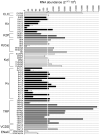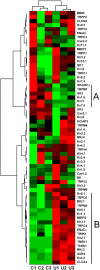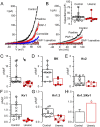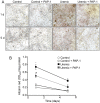Kv1.3 Channel Inhibition Limits Uremia-Induced Calcification in Mouse and Human Vascular Smooth Muscle
- PMID: 35330975
- PMCID: PMC8788811
- DOI: 10.1093/function/zqaa036
Kv1.3 Channel Inhibition Limits Uremia-Induced Calcification in Mouse and Human Vascular Smooth Muscle
Abstract
Chronic kidney disease (CKD) significantly increases cardiovascular risk. In advanced CKD stages, accumulation of toxic circulating metabolites and mineral metabolism alterations triggers vascular calcification, characterized by vascular smooth muscle cell (VSMC) transdifferentiation and loss of the contractile phenotype. Phenotypic modulation of VSMC occurs with significant changes in gene expression. Even though ion channels are an integral component of VSMC function, the effects of uremia on ion channel remodeling has not been explored. We used an in vitro model of uremia-induced calcification of human aorta smooth muscle cells (HASMCs) to study the expression of 92 ion channel subunit genes. Uremic serum-induced extensive remodeling of ion channel expression consistent with loss of excitability but different from the one previously associated with transition from contractile to proliferative phenotypes. Among the ion channels tested, we found increased abundance and activity of voltage-dependent K+ channel Kv1.3. Enhanced Kv1.3 expression was also detected in aorta from a mouse model of CKD. Pharmacological inhibition or genetic ablation of Kv1.3 decreased the amount of calcium phosphate deposition induced by uremia, supporting an important role for this channel on uremia-induced VSMC calcification.
Keywords: BK channels; chronic kidney disease; ion channel remodeling; phenotypic switch; voltage-dependent potassium channels.
© The Author(s) 2020. Published by Oxford University Press on behalf of American Physiological Society.
Figures










Comment in
-
Kv1.3 Channel, a Targetable Piece in the Complex Jigsaw Puzzle of Vascular Calcification?Function (Oxf). 2020 Dec 28;2(1):zqaa049. doi: 10.1093/function/zqaa049. eCollection 2021. Function (Oxf). 2020. PMID: 35330970 Free PMC article. No abstract available.
Similar articles
-
Efficacy of linalool to ameliorate uremia induced vascular calcification in wistar rats.Phytomedicine. 2018 Dec 1;51:191-195. doi: 10.1016/j.phymed.2018.10.007. Epub 2018 Oct 12. Phytomedicine. 2018. PMID: 30466616
-
Autophagy Protects From Uremic Vascular Media Calcification.Front Immunol. 2018 Aug 14;9:1866. doi: 10.3389/fimmu.2018.01866. eCollection 2018. Front Immunol. 2018. PMID: 30154792 Free PMC article.
-
Uremic serum-induced calcification of human aortic smooth muscle cells is a regulated process involving Klotho and RUNX2.Biosci Rep. 2019 Oct 30;39(10):BSR20190599. doi: 10.1042/BSR20190599. Biosci Rep. 2019. PMID: 31519772 Free PMC article.
-
The Impact of Uremic Toxins on Vascular Smooth Muscle Cell Function.Toxins (Basel). 2018 May 29;10(6):218. doi: 10.3390/toxins10060218. Toxins (Basel). 2018. PMID: 29844272 Free PMC article. Review.
-
Contribution of Gut Microbiota-Derived Uremic Toxins to the Cardiovascular System Mineralization.Toxins (Basel). 2021 Apr 10;13(4):274. doi: 10.3390/toxins13040274. Toxins (Basel). 2021. PMID: 33920096 Free PMC article. Review.
Cited by
-
Kv1.3 Channel, a Targetable Piece in the Complex Jigsaw Puzzle of Vascular Calcification?Function (Oxf). 2020 Dec 28;2(1):zqaa049. doi: 10.1093/function/zqaa049. eCollection 2021. Function (Oxf). 2020. PMID: 35330970 Free PMC article. No abstract available.
-
Therapeutic potential of voltage-dependent potassium channel subtype 1.3 blockade in alleviating macrophage-related renal inflammation and fibrogenesis.Cell Death Discov. 2025 May 5;11(1):218. doi: 10.1038/s41420-025-02508-7. Cell Death Discov. 2025. PMID: 40324999 Free PMC article.
References
-
- Tonelli M, Pfeffer MA.. Kidney disease and cardiovascular risk. Annu Rev Med 2007;58:123–39. - PubMed
-
- Benz K, Varga I, Neureiter D, et al.Vascular inflammation and media calcification are already present in early stages of chronic kidney disease. Cardiovasc Pathol 2017;27:57–67. - PubMed
-
- Moe SM, Chen NX.. Pathophysiology of vascular calcification in chronic kidney disease. Circ Res 2004;95(6):560–7. - PubMed
-
- Chen NX, Duan D, O'Neill KD, et al.The mechanisms of uremic serum-induced expression of bone matrix proteins in bovine vascular smooth muscle cells. Kidney Int 2006;70(6):1046–53. - PubMed
Publication types
MeSH terms
LinkOut - more resources
Full Text Sources
Medical
